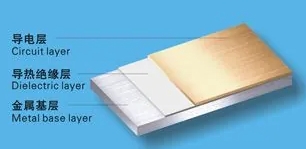
Aluminum printed circuit board (PCB) is a kind of metal base copper clad board with good heat dissipation function. Generally, a single panel is composed of three layers, which are circuit layer (copper foil), insulation layer and metal base. For high-end use there is also a design for double panels, the structure of the circuit layer, insulation layer, aluminum base, insulation layer, circuit layer. Very few applications for multilayer board, can be made of ordinary multilayer board and insulation layer, aluminum base laminated.

Single aluminum substrate: is only one layer of conductive graphics layer and insulation materials plus aluminum (substrate).
Double-sided line aluminum substrate: there are two layers of conductive graphics layer and insulation material plus aluminum (substrate) superimposed together.
Multilayer printed aluminum-based circuit board: a printed circuit board made by bonding three or more layers of conductive graphics with alternating layers of insulating material and aluminum (substrate).
According to the surface treatment method to be divided into:
Gold board (chemical thin gold, chemical thick gold selective gold deposition)
Electro gold board (full board electro gold , finger selective electro gold)
Tin jet board
Molten tin board
Heavy tin board
Silver board
Electro silver board
Palladium board
The circuit layer (generally using electrolytic copper foil) is etched to form a printed circuit for the assembly and connection of devices. Using the same thickness and wire width, the aluminum substrate can carry higher current than the traditional fr-4.
Insulation layer is the core technology of aluminum substrate, mainly playing the role of bonding, insulation and heat conduction. Aluminum substrate insulation layer is the largest thermal barrier in power module structure. The better the heat conduction performance of the insulation layer is, the more beneficial it will be for the heat generated during the device operation to diffuse, and the more beneficial it will be for reducing the operating temperature of the device, so as to improve the power load of the module, reduce the volume, extend the service life and increase the power output.
The metal used for the metal base insulation metal substrate depends on the comprehensive consideration of the thermal expansion coefficient, thermal conductivity, strength, hardness, weight, surface state and cost of the metal substrate.